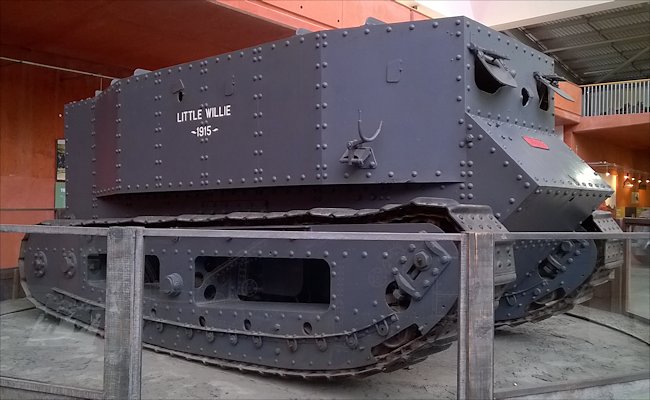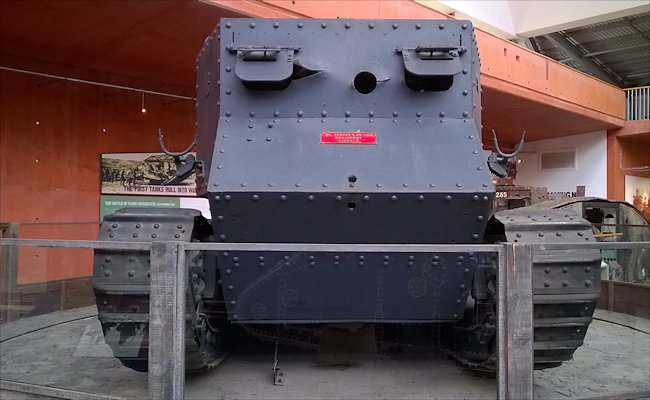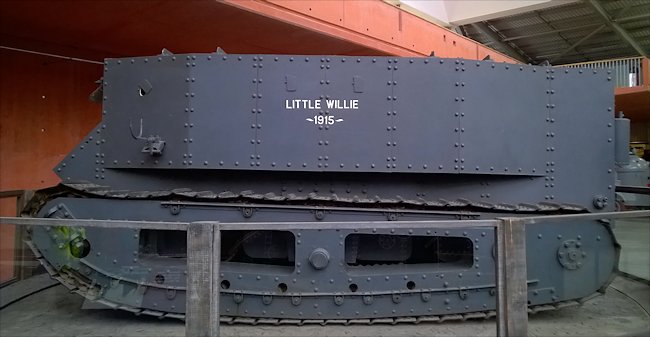The 'Little Willie' 1st Tank
This WW1 British first prototype tank called Little Willie. It was an Armoured Personel Carrier. It can be found at the Tank Museum, Bovington, Dorest, BH20 6JG, England. Their website is tankmuseum.org.

WW1 British First tank called Little Willie.
We need an armoured landship destroyer!
The Allies need something that would enable them to break out of the stalemate of trench warfare. Lieutenant-Colonel Ernest Swinton, a Royal Engineer Officer submitted a paper to the British Army General Headquarters GHQ on 1st June 1915 advocating the use of ‘Armoured Machine Gun Destroyers’ to overcome the impasse.
He went on to specify that the ‘Destroyers’ would utilise petrol tractors on the caterpillar principle that were already used on farms and building site. Swinton went on to insist that they be armoured with hardened steel plates proof against German steel-cored, armour piercing and reversed bullets. He suggested that they be fitted with two maxims and a 2pdr gun. The intent was for this vehicle to directly engage with opposing enemy machine gun posts on advantageous terms.

The 1915 WW1 British First tank Little Willie was not fitted with guns.
The Royal Artillery were already using caterpillar tracked vehicles to tow heavy artillery guns in France. Lieutenant-Colonel Maurice Hankey read Swinton’s paper and shared his view that this was the weapon that could be the solution to the ‘break through’ problem. He the secretary to the Committee of Imperial Defence and was very influential. He knew the people to talk to.
They submitted a joint paper to the War Office on Boxing Day 1914. Some dismissed it as a work of fancy but the paper came to the attention of the First Sea Lord at the Admiralty, Winston Churchill. He saw the merits of this idea. He endorsed Swinton and Hankey's memo and sent it to Prime minister Asquith at the end of 1914. Churchill had also been approached by officers of the Royal Naval Air Service Armoured Car Squadron, which was under his jurisdiction, to set up a ‘Landship Committee’ in February 1915, to look into the matter. He diverted the necessary funds to pay for the development. It is strange that the development of the Army tank has the Navy to thank.

WW1 British First tank called Little Willie.
By June 1915 a War Office specification was issued for a machine armed with two machine-guns and a quick firing light gun crewed by ten men, capable of crossing broken ground and barbed wire. A top speed of not less than ten miles an hour on flat ground with a sharp turn and reverse capability was needed. The machine had to climb five foot earth parapets and travers eight foot gaps.
In short, the War Office wanted a machine that could cross a shell cratered no-mans land and drive over enemy trenches whilst shooting machine guns and shells at the enemy positions. William Foster’s of Lincoln was awarded the contract on 24th July 1915.
The Royal Navy offered the use of 6pdr guns and ammunition. Sources of armour plate and machine guns were identified. A 105hp Damiler engine was chosen as it was already in production. The big problem for the development team was the shape of the vehicle and where to find a caterpillar track and suspension system that could cope with the heavy weight, the difficult terrain and trench crossing.
Within three weeks of being awarded the contact a tracked metal box prototype called ‘Little Willie’ was produced. After a number of trials, shortfalls were identified with the box design. Major Walter Wilson was heavily involved in solving some of the early mechanical teething problems such as minimal ground clearance, top as well as front heaviness and insufficient track length. This meant that in trials the Little Willie tank would crash down into trenches and not have enought length of body to bridge enemy trenches. He went on to design the rhomboidal shape that became the Mark I tank.
WW1 tank books

